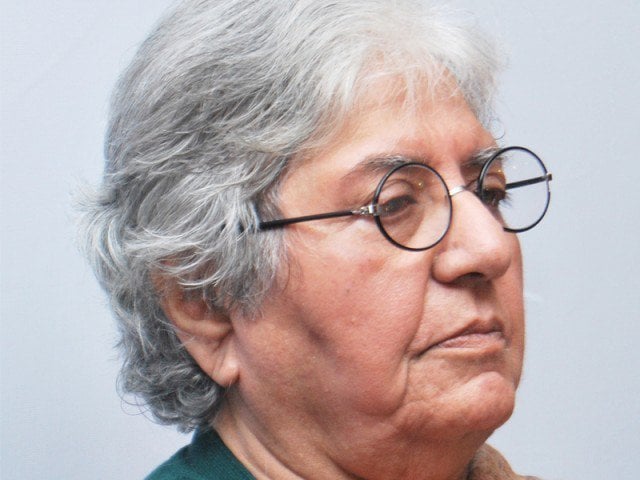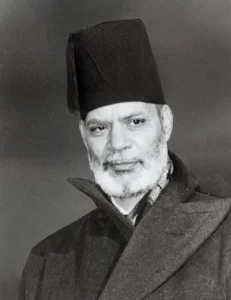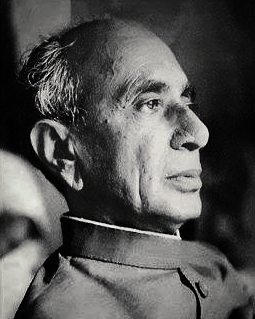
Sindh’s struggle revolved around two points – it was believed that Sindh would be an independent and sovereign country – Dr. Hamida Khuhro
[Translator’s note: This is a translation of renowned historian Dr. Hamida Khuhro’s comprehensive interview, originally published in the Sindhi magazine Nao Niapo, Karachi in May, 1986. The interview panel consisted of Advocate Masood Noorani, Journalist Nasir Aijaz and Faqir Muhammad Lashari, with Mansoor Qadir Junjo’s assistance to the interviewers. Masood Noorani also contributed observation notes from his initial meeting with Dr. Khuhro, which were used as a preamble to the interview. The interview was later included in an anthology that contained interviews of Dr. Khuhro, published in various Sindhi newspapers and magazines.
In 2021, Dr. Hamida Khuhro Foundation, Sindh (Karachi-Hyderabad) published Nao Napo magazine’s interview as a separate booklet with a title of ‘Tareekh Ji Amhon Samhon’ (Face-to-Face with History). The booklet includes a preface by Mansoor Qadir Junejo. Zaffar Junejo]
MN: Raees Ghulam Muhammad Bhurgri didn’t talk about Sindh’s separation. In fact, his demands were four: Sindh should enjoy the status of the other provinces of the Presidency, the powers of Sindh’s Commissioner should be limited, Sindh and Baluchistan should be merged to form one province, and he also tabled other options. I believe he proposed these options because he thought Sindh was not able to generate and manage its own financial resources. However, it is on record that the issue of Sindh’s separation was raised and argued more by Muhammad Ayub Khuhro.
HK: Actually, Raees Ghulam Muhammad Bhurgri argued in favor of Sindh’s separation, but alternatively, he suggested that if the idea of Sindh’s separation is ahead of its time, then Sindh should be made a regular division. I think his point of view should be evaluated in those particular times. However, it should be noted that he never uttered or advocated that Sindh shouldn’t be separated from the Bombay Presidency. You may look at our own demand; now we are demanding Sindh’s independence. Are our demands rooted in any ulterior motive? We should evaluate and criticize any event in the perspective of those particular times. We should understand that Ghulam Muhammad Bhurgri’s approach was systematic and procedural. Additionally, I think in those times, there was stress and contradiction between urban and rural areas, and sadly, it still exists.
FM: Madam, isn’t it appropriate that instead of the urban and rural terminology, we should use the bourgeois and middle class, as they were in contradiction to each other?
HK: The bourgeois class in Sindh didn’t exist. But let us elaborate on that term and understand who represents that term in Sindh. Based on that narrow definition, before partition, only Hindus were fit, and now it suits non-Sindhis. Prior to the partition, Hindus represented that term because they were in cities and engaged in trade. However, we should understand that at that time there was no industry, only trade was there as a business. Now the question arises, who were those ‘haven’t’? Those were Haris, associated with the land and lived in rural areas, and that situation still continues. We should realize that even now, the laborer and their dynamics in rural and urban areas are quite different. Now another question arises, in those times, who was exploiting rural people? Who was the middleman? Obviously, these exploiters were urban dwellers.
It was never realized that there would be riots and Hindus would migrate. It was never thought that Hindus would migrate and that migrants would come and settle in Sindh.
FM: Do you agree that Sindh was a cultural unit?

HK: Yes, it was. But we shouldn’t mix our feelings with the objective realities of those times. We have to do an objective analysis of exploiters and the exploited and who benefited. The reality is that in those days, Hindus were living here, and their language was Sindhi. One more thing, I still hold the view that Sindhi language is our only identity, and it will unite us. Its loss is the loss of a nation. I am not interested in or inclined towards any community or communal idea. But I strongly believe that if Sindhi language stands and flourishes, then we as a nation stand and advance. There is no doubt that the presence of Hindus was beneficial to Sindh, and their migration has caused a significant loss to Sindh and the Sindhi language. Surely, that argument has its own importance, but if we discuss Sindh of those times, then we have to tell and establish that on economic and financial ground who bore the loss and who benefited. Therefore, roughly, I state that the ‘working class was rural people and the bourgeois’ were urban people, and sadly that system still exists.
NA: Let me revert to my earlier question about the Pakistan Resolution. I read somewhere that the Pakistan Resolution’s draft was not prepared by the Muslim League, but it was prepared by English people. Is it true?
HK: In those times, there were different schemes. One draft was also prepared by Sir Zafarullah Khan, therefore it is believed that the Pakistan Resolution was prepared by the English people. However, in those times, the ‘Pakistan scheme’ was a common topic of political discourse. You can link it to the present-day discussions about and around confederation, and none is sure about its future. But it is not true that English people dictated the draft. There may have been their influence, and there were different schemes. However, after the arrival of Lord Mountbatten, the situation became clearer.
Read: Sindh Assembly passes Pakistan Resolution – Assembly Proceedings
NA: Sindh Assembly passed a resolution regarding Pakistan, which also advocates that within an independent country, there would be another independent country…

HK: (She interrupts the question) Yes, the resolution of 1940, which is called the Pakistan Resolution… Its sole objective in our context was that Sindh would be independent. Afterwards, the Sindh Assembly passed the resolution of 1943, and we shouldn’t forget that Sindh’s struggle revolved around two points/resolutions, and it was believed that Sindh would be an independent and sovereign country. In those times, the Acts of the English Government, particularly the Act of 1919 and then the Act of 1935, supported Sindh’s belief and political understanding. Honestly, it was one way to unite Hindustan – to grant more power and rights to the provinces. Although the English government retained the ‘veto-power’ type clauses in those reform Acts, they considerably liberated the provinces, particularly in economic domains. Therefore, Sindh believed that in the constitution of a new country, there would be more rights, and Sindh would enjoy more liberty. Just look at the Act of 1935, it offered a lot to the provinces. Vaguely, Sindhis thought that in a new country, their governor would enjoy the same rights and status, including ‘veto power’ regarding the united states (Pakistan) that was availed by the English Governor. It means within the state we would be independent, except in matters of foreign affairs and other departments – and we would be sovereign.
FM: It means, first we were guaranteed our liberty, autonomous status, and then we were cheated?
HK: Yes, it was not thought of, and even migration was not thought of. It was never realized that there would be riots and Hindus would migrate. It was never thought that Hindus would migrate and that migrants would come and settle in Sindh.
MN: There are three situations: Sindh’s separation from Bombay, the establishment of Pakistan, and the formation of One Unit. According to your assessment, which scheme became dangerous for Sindh?
HK: (giggles and halts it). Before me, the first number comes of Pakistan. It is so because once you are trapped in such a country where the military and bureaucracy are too strong and not responsible for their deeds, and we are in their laps, and it has become their prerogative to decide about us. (Continues)
Click here for Part-I and Part-II (Preamble) – Part-!II , Part-IV , Part-V , Part-VI , Part-VII
________________
 Dr. Zaffar Junejo is a historian and a writer, having earned Doctorate from the Department of History University of Malaya, Malaysia. Presently, Mr. Junejo is associated with the European University Institute, Florence, Italy. Apart from scholarly contribution, he also writes for popular media. He could be accessed at: Email junejozi@gmail.com, Cell/WhatsApp +92 334 045 5333 Skype Zaffar.Junejo Facebook facebook.com/zaffar.junejo
Dr. Zaffar Junejo is a historian and a writer, having earned Doctorate from the Department of History University of Malaya, Malaysia. Presently, Mr. Junejo is associated with the European University Institute, Florence, Italy. Apart from scholarly contribution, he also writes for popular media. He could be accessed at: Email junejozi@gmail.com, Cell/WhatsApp +92 334 045 5333 Skype Zaffar.Junejo Facebook facebook.com/zaffar.junejo